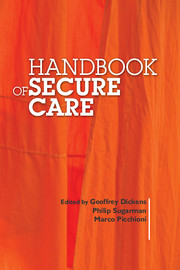Book contents
- Frontmatter
- Contents
- List of tables, boxes and figures
- List of contributors
- Preface
- 1 The evolution of secure and forensic mental healthcare
- 2 Mental disorder and offending
- 3 Clinical risk assessment in secure care
- 4 Risk management in secure care
- 5 Recovery in secure environments
- 6 Personality disorder
- 7 Women's mental health, aggression and offending
- 8 Offenders with intellectual disability in secure services and the criminal justice system
- 9 Secure mental healthcare for young people
- 10 Secure care for people with autism spectrum disorder
- 11 Acquired brain injury, trauma and aggression
- 12 Managing aggression and violence in older people
- 13 Firesetting in secure settings: theory, treatment and management
- 14 Specialist psychological treatment programmes in secure mental healthcare
- 15 Nursing in secure mental healthcare settings
- 16 Prescribing for specialist populations
- 17 Human rights in secure psychiatric care
- 18 Quality assurance and clinical audit in secure psychiatric care
- 19 Psychological support following violent assault and trauma: what works for staff in secure settings?
- Index
4 - Risk management in secure care
Published online by Cambridge University Press: 02 January 2018
- Frontmatter
- Contents
- List of tables, boxes and figures
- List of contributors
- Preface
- 1 The evolution of secure and forensic mental healthcare
- 2 Mental disorder and offending
- 3 Clinical risk assessment in secure care
- 4 Risk management in secure care
- 5 Recovery in secure environments
- 6 Personality disorder
- 7 Women's mental health, aggression and offending
- 8 Offenders with intellectual disability in secure services and the criminal justice system
- 9 Secure mental healthcare for young people
- 10 Secure care for people with autism spectrum disorder
- 11 Acquired brain injury, trauma and aggression
- 12 Managing aggression and violence in older people
- 13 Firesetting in secure settings: theory, treatment and management
- 14 Specialist psychological treatment programmes in secure mental healthcare
- 15 Nursing in secure mental healthcare settings
- 16 Prescribing for specialist populations
- 17 Human rights in secure psychiatric care
- 18 Quality assurance and clinical audit in secure psychiatric care
- 19 Psychological support following violent assault and trauma: what works for staff in secure settings?
- Index
Summary
Introduction
Risk management is central to clinical practice in secure settings and should be determined by informed risk assessment. In the previous chapter we identified that risk assessment should use the information gathered to anticipate and plan for likely scenarios where the individual's risk might be heightened. The subsequent development of risk management strategies from that process is integral to, and is in many respects the most important result of, that process. Risk management has both shorter- and longer-term objectives. The immediate aim is to manage the patient on a day-to-day basis, ensuring their safety and that of others. This should be supplemented by the implementation of strategies to reduce risk over the longer term, and to ameliorate and minimise the effects of risk behaviour when it occurs. In the previous chapter we identified that structured professional judgement (SPJ) involves a systematic approach to risk assessment (Box 4.1). Further, risk assessment is performed for a specific person, at a particular time and for their own unique circumstances. In this chapter we concentrate on risk management in the secure setting, where a considerable proportion of the available risk management interventions are achieved by the therapeutic application of security measures. We therefore provide an overview of physical, procedural and relational security and discuss how their proportionate use can ensure an appropriate level of security for the individual. We describe approaches to the management of violence and aggression in secure care, the management of suicidal and self-harming behaviour and, briefly, a range of other risk behaviours relevant to the secure setting.
Risk and security
In secure mental health settings the context for the safe delivery of care and therapeutic interventions is, by definition, provided by the clinical security arrangements. Importantly, security and therapy should be viewed as
Box 4.1 Six stages of structured professional judgement
Step 1: Gather information
Step 2: Consider presence and relevance of risk factors – historical, current, contextual, protective
Step 3:Develop a risk formulation – motivators (drivers), (dis)inhibitors, destabilisers
Step 4: Consider risk scenarios, e.g. repeat, escalation, twist
Step 5: Develop risk management strategies
Step 6: Summary of judgement
Source: Hart et al (2003)- Type
- Chapter
- Information
- Handbook of Secure Care , pp. 48 - 66Publisher: Royal College of PsychiatristsPrint publication year: 2015

